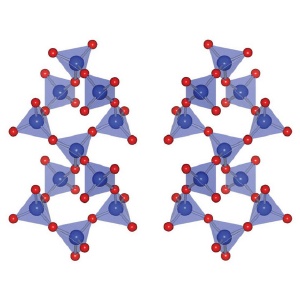Aug 15 2008
Many proteins, sugars and pharmaceuticals crystallize into two forms that are mirror images of one another-similar to the way a left and right hand mirror each other. Often, the two structures of these so-called enantiomers can have very different chemical properties.
 á-quartz (SiO2) forms two crystal structures that are mirror images of one another. With circularly polarized x-rays that are tuned to the Si absorption edge, it is possible to tell the ‘left quartz’ (left) from the ‘right quartz’ (right).
á-quartz (SiO2) forms two crystal structures that are mirror images of one another. With circularly polarized x-rays that are tuned to the Si absorption edge, it is possible to tell the ‘left quartz’ (left) from the ‘right quartz’ (right).
The polarization of light typically changes depending on whether it passes through a ‘left-’ or ‘right-handed' form of an enantiomer, providing a convenient means to tell them apart. X-rays, which are normally useful in determining the structure of materials and biomolecules, are much less sensitive to the ‘handedness’ of an enantiomer. Now, a team of scientists from Japan and the UK have shown that circularly polarized x-rays of the right energy can distinguish ‘left’ from ‘right’ a-quartz1.
In the left and right forms of single-crystal a-quartz (SiO2), the Si-O tetrahedra spiral in opposite directions, but conventional x-rays cannot tell them apart. Team-member Yoshikazu Tanaka, an expert in x-ray diffraction at the RIKEN SPring-8 Center in Harima, says he found a way to separate these two forms of quartz essentially “by chance”. His colleagues were testing an x-ray diffractometer with a quartz crystal when they observed that the intensity of a diffraction peak from the quartz varied with the energy of the x-ray beam. This variation occurred particularly when the x-ray energy was near the atomic absorption edge of Si that occurs at 1.85 keV.
Tanaka suggested using the same x-ray energy to look for a reflection in a-quartz that is normally forbidden by the symmetry of the crystal. Such a reflection could, he thought, be used to distinguish left from right if it became visible.
The idea worked: the team found the reflection and saw that at the ‘resonant’ energy of 1.85 keV, the intensity of the reflection depended on whether the crystal was of the left or right form. The fact that the x-rays were circularly polarized, as opposed to linearly polarized, was also essential to observe the large difference.
Much is already known about a-quartz but physicists would benefit from understanding how the handedness (also known as chirality) of a crystal develops as it grows. The team’s x-ray technique has a clear advantage over optical techniques when applied to non-transparent materials such as metals or oxides, says Tanaka.
Tanaka is ultimately interested in using this technique to explore the role of chirality in a broad range of materials, including liquid crystals, biochemicals, magnets and multiferroics.
Reference
Tanaka, Y., Takeuchi, T., Lovesey, S. W., Knight, K. S., Chainani, A., Takata, Y., Oura, M., Senba, Y., Ohashi, H. & Shin, S. Right handed or left handed? Forbidden x-ray diffraction reveals chirality. Physical Review Letters 100, 145502 (2008).